Affiliate Disclosure: As an Amazon Associate we earn advertising fees from qualifying purchases. learn more.
If you’re looking to bring more alternative energy sources into your lifestyle, you might be considering some vertical axis wind turbines (VAWT) that you can install right on your own property. There are plenty of small vertical-axis windmill models available on the market today that allow the average homeowner access to generate their own green power source.
The best vertical wind turbines are small and easy to install, featuring multiple blades that will begin generating power with light winds. Combining Darrieus and Savonieus blade styles maximizes the turbine’s ability to maximize efficiency and can be found on MAKEMU models. The best vertical axis wind turbine to buy is the MAKEMU DOMUS Vertical Turbine. It is great for residential use. It can generate up to 1 KiloWatt energy.
If you live in an area that catches good gusts of wind regularly, choosing a vertical axis wind turbine or windmill would be a great choice for you, as it’s perfect for homeowners and beginners in the world of green energy.
In this article, we will take a closer look at each of the top options you have to help you decide which one is best suited for you and your house. We will also discuss how you can build your own VAWT and how important it is to utilize our natural energy sources.
These models below consist of different windmill design features, wattage, and voltage capacities, but all are suitable for a beginner looking to get started with personal green energy use. Let’s take a look at some of the top picks.
#1. MAKEMU DOMUS Vertical Turbine
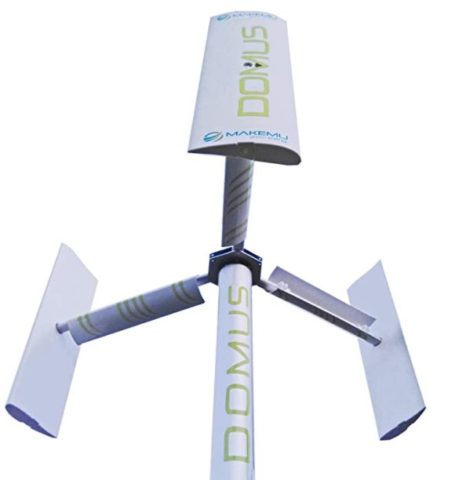
| Name | MAKEMU Dolmus Vertical Turbine |
| Wattage | 500W / 750W / 1KW |
| Voltage | 110V / 220 V |
| Blade Count | 3 or 6 |
| Purpose | House |
This first pick is a model that combines key elements of both the Darrieus and Savonius designs. Depending on your needs, you can choose between the three-blade design or the larger six-blade design. Each turbine comes with either three or six of Darrieus and Savonius blades. This variety of blade styles works together to catch the wind most effectively and give you the best chance of harnessing the natural energy on your property.
This product weighs about 15.5 pounds (7 kg), so it is manageable for anyone looking to start setting up a turbine at home. It will operate quietly and well-converting even light winds into a real, tangible power source you can use.
This model has variations you can choose from when it comes to maximum wattage. For smaller-scale use, you could select the 500-watt model. It also comes in 750 watts or 1000 watts (1KW), giving you options to seek a more powerful turbine.
The design is sleek and appealing, and its price point is in the mid-range. Coming in at around 1000 dollars, it is an investment that should give a good, long, durable life and reliable energy output. MAKEMU is a recognized producer of turbines located in Italy and is a good choice for a first brand.
#2. Pikasola Vertical Wind Turbine
| Name | Pikasola Vertical Wind Turbine |
| Wattage | 200W |
| Voltage | 12V |
| Blade Count | 5 |
| Designed For | Residential use |
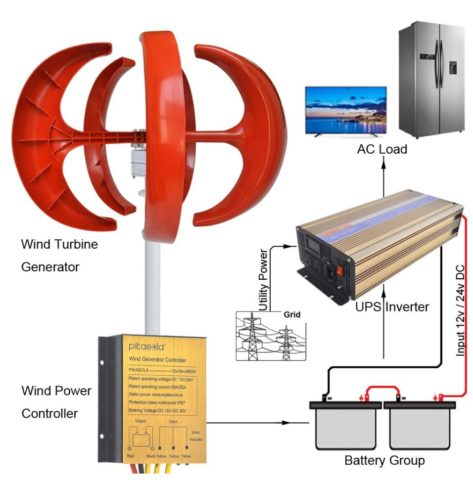
This cute little red turbine is an excellent starting option. It is one of the more affordable options, coming in at less than $300. The design has been developed both to catch light winds and ensure the operator’s safety. The color is bright red to ensure visibility, and each of the five blades is coated with fiber nylon to be both safe and aerodynamic.
A beginner can install this turbine, making it another great choice for someone just getting started with do-it-yourself wind energy. It is available in various wattages and voltages, and you can choose which is the best match for your property.
While still durable, it will not be as tough against the elements as some other models we will see. It has a limit of only 200 watts, so it definitely is best for small-scale energy production. This is really a good starter choice, but if you are looking for a more serious turbine with more capability, keep reading on to our next pick.
#3. MAKEMU EOLO 3000 Vertical Turbine
| Name | MAKEMU EOLO 3000 Vertical Turbine |
| Wattage | 1KW / 2KW / 3KW |
| Voltage | 110V / 220 V |
| Blade Count | 3 or 6 |
| Purpose | Home |
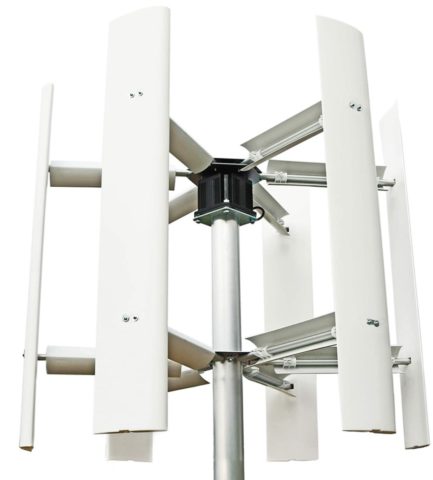
If you are looking for something top of the line that can handle harnessing more energy, this EOLO model by MAKEMU might be perfect for you. This model is more heavy-duty, and it is the first we have seen here that could also be suitable for some limited industrial use instead of just residential.
However, you will have to think of the EOLO 3000 as more of an investment. With its price point being on the higher end of the models we are comparing here, around $4000, it is best to know your property and wind speeds well and make an informed decision if this type of turbine will ultimately pay off for you.
If you liked the sound of the MAKEMU Energy model we previously discussed, this EOLO version should also appeal to you. It utilizes a similar combination of both Darrieus and Savonius constructions to capture the wind most effectively. However, unlike the MAKEMU, it has 6 Darrieus blades and 12 Savonius blades in its construction.
This model is not as sleek in appearance, but it is definitely stronger and more capable as a turbine. Coming in at a 66-pound (30 kg) weight, it is certainly the heftiest model we have seen so far. It has a 3KW limit, which is on the higher end for the typical VAWT. However, even with its more advanced capabilities, it is still easy to set up and can still be recommended to a motivated beginner.
#4. IceWind’s Freya Vertical Turbine
| Name | IceWind’s Freya Vertical Turbine |
| Wattage | 600W |
| Voltage | 12V / 24V / 48V |
| Blade Count | 6 |
| Best For | Houses |
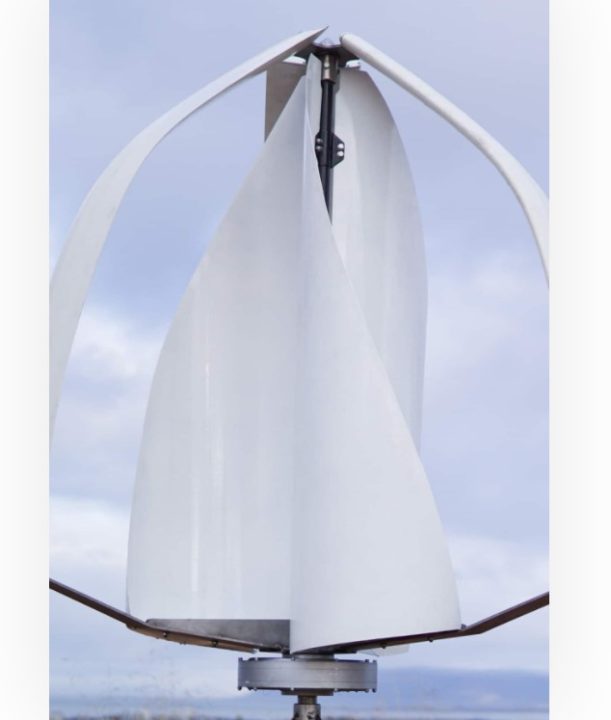
This Icelandic company has designed a high-quality turbine that is also being made available to consumers in the United States. This new Freya Model features six blades that will start turning even with low wind speeds to get started. The turbine is constructed from aluminum and stainless steel, perfect for withstanding all the outdoor elements, ensuring your investment will keep working for you and the environment for many years to come.
However, this model is best for a consumer that is a bit more serious about their wind turbines. Weighing in at around 140 pounds (64 kg), it is definitely the heftiest model we have seen here. It will give you a maximum of 600 watts of energy output and operates quietly at less than 30 decibels of sound. That is one of the quieter options we have seen so far.
The price point is on the higher end, currently costing over $3000. However, this company takes great pride in the quality and durability of their products. They promise minimal cost and maintenance to the consumer over the twenty-year period that follows installation and the start of use.
#5. AIBOAT Wind Turbine
| Name | AIBOAT Wind Turbine |
| Wattage | 400W / 600W |
| Voltage | 12V / 24V |
| Blade Count | 3 |
| Designed For | Outdoor Homes |
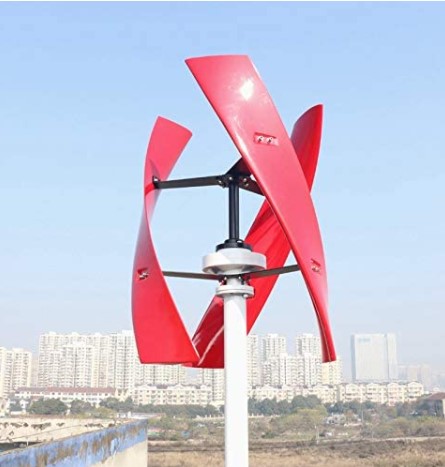
This three-bladed AIBOAT model is another great choice with low starting wind speeds and small, sleek construction. You can choose between the 12 volt/400 watt or 24 volt/600 watt models depending on your wind’s strength and your intended power output.
With current pricing under $1000, this is a nice mid-range option that will still be manageable with a weight of fewer than 50 pounds (23 kg). Its sleek design and bright color make it a good choice for those concerned about appearance and visibility.
#6. KISSTAKER Lantern Turbine
| Name | KISSTAKER Lantern Turbine |
| Wattage | 4KW |
| Voltage | 12V |
| Blade Count | 5 |
| Best For | House |
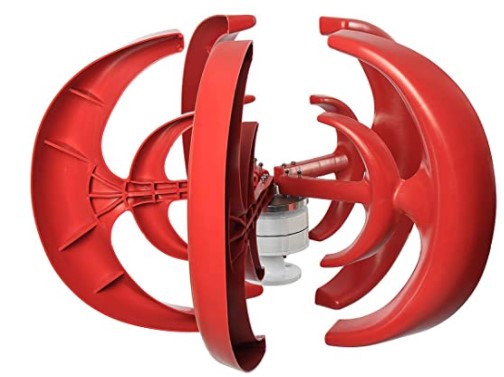
Here we have another great choice for a beginner looking for an affordable option to get started. This model from KISSTAKER features 5 blades that can theoretically obtain up to 4000 watts (4KW) of output. However, the likely output is probably much lower. Still, it is designed to be sensitive to slow starting wind speeds and should begin generating power for you right away.
Another model made from nylon fiber, it may not have the longevity that we see in some of the other models, but for a few hundred dollars, it may be worth giving it a try and seeing what kind of output and energy savings it brings you.
#7. MAKEMU SmartWind Wind Generator
| Name | MAKEMU SmartWind Wind Generator |
| Wattage | 300W / 400W / 500W |
| Voltage | 110V / 220 V |
| Blade Count | 3 or 6 |
| Best For | Small Houses |
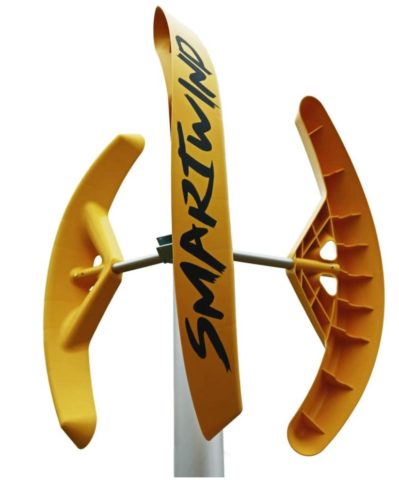
This simple, three-blade design from MAKEMU is a nice startup option. It is the smallest and most affordable option made by this company. You have three choices in wattages, either 300, 400, or 500 watts. You can also upgrade to 6 blades if that is more appealing for you in this model.
The price goes up accordingly with wattage and blade count, so if you are looking for a small option that is easy on the wallet, the 300-watt turbine with three blades could be a great choice for you.
This model is also advisable for alternate environments where you might be seeking a power source, for example, if you are out in the woods camping or looking for a bit of power for your houseboat.
- RV flexible solar panels
- Home Solar tubes 2021
- Solar Pool Heaters Review
- Solar Attic Fans for home
- Solar String Lights for garden
- Best Solar Deck Lights for Garden
Topics Covered ⬇⬇
- #1. MAKEMU DOMUS Vertical Turbine
- #2. Pikasola Vertical Wind Turbine
- #3. MAKEMU EOLO 3000 Vertical Turbine
- #4. IceWind’s Freya Vertical Turbine
- #5. AIBOAT Wind Turbine
- #6. KISSTAKER Lantern Turbine
- #7. MAKEMU SmartWind Wind Generator
- Features of a House Vertical Axis Wind Turbine
- Voltage vs. Wattage: What You Need to Know
- DIY Option: Build Your Own Vertical Axis Wind Mill
- Why Is It Important to Utilize Natural Energy Sources?
- Final Thoughts
- Sources
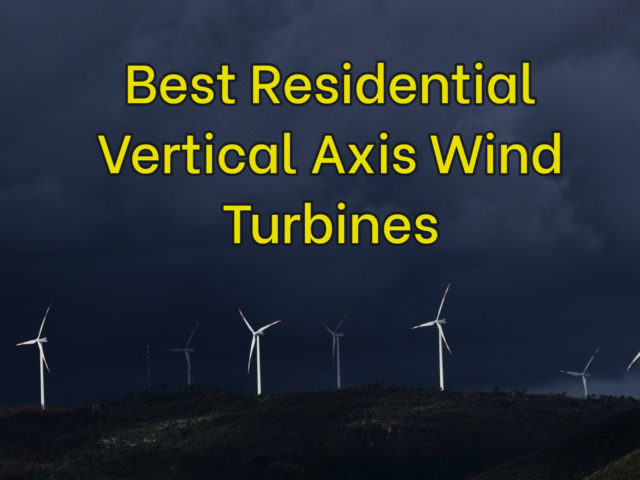
Features of a House Vertical Axis Wind Turbine
Many design features make a VAWT a very low-maintenance, hands-off renewable power source. Now that we have some choices, let’s take a closer look at what makes a great VAWT and why this type of turbine is suitable for the residential sector. We will also see some drawbacks and limitations of this type of turbine.
Pros of a VAWT
There are many reasons that these are the choice of residential homeowners all over the country. Let’s see the pros of these turbines.
Wind Direction
One of the great features of a VAWT is its ability to pick up wind from any direction. There is no need to recalibrate these little turbines depending on the wind’s direction on a certain day. They typically can begin to operate at slow wind speeds; no matter where these winds are coming from, they will get your VAWT to start spinning.
Compared to the large scale HAWT, this is a great advantage. There is no need to research how the wind blows and assemble your turbine based on this research type. This is necessary with the industrial horizontal designs, and by eliminating this requirement in the residential vertical turbine, they become much more accessible to the average homeowner.
Durability
The upkeep of your VAWT will also be quite easy. After what is usually a very easy installation, many companies are confident that their turbines should have a long, healthy life of around 20 years. Many come with 1-2 warranties for anything immediately wrong, but as long as there are no defects, you should collect energy for a long time after purchase.
These turbines should require very little maintenance, and most are made to withstand high winds and rough weather.
Quiet Operation and Small Profile
No matter if you are way out in the country or have some neighbors close by, most VAWTs are small and operate quietly. Most brands advertise less than 45 decibels of sound, so they will not cause a disturbance to you or those around you. Unlike the industrial-sized HAWTs, you will not have to worry about special permits and permissions to install these on your property.
Their smaller scale and proximity to the ground makes them less obvious, and less of an eye-sore than the larger scale turbines can be seen as being.
Environmental Responsibility
Another pro of a VAWT is that it does not pose the same problem to birds as the larger-scale HAWTs have shown to cause. Birds will not be put in an increased danger by installing a vertical turbine on your property. The bright color of many of these models will make it easily visible for humans and animals alike.
Of course, like all sustainable energy options, the truly beautiful thing about vertical wind turbines is that they harness a never-ending natural resource without producing harmful side effects. There is no harm in setting up a VAWT, taking advantage of sustainable energy options, and reducing your carbon footprint.
Cons of a Vertical Axis Windmill (VAWT) or Wind Turbine
However, these turbines are really good at what they are designed for, but not much more. Let’s see their cons below.
Supplemental Energy Only
They do a wonderful job creating an alternate energy source for a residential setting, but it would be challenging to use these turbines as your sole source of energy. They are a great supplement to a primary source, but they are typically unable to require the power you would need to meet all of your daily requirements.
Their small and sleek design is quite advantageous for many homeowners, but it also means they are not high enough off the ground to take advantage of the strong winds blowing above. Since the winds closer to the ground typically have obstacles such as other buildings and structures, they are not usually as strong as winds higher off the ground. Their low-to-the-ground build is a great accessibility feature but does mean they are not as powerful.
Vertical Wind Turbine Design Basics: Darrieus vs. Savonius
Historically, there have been two lasting inventions in terms of vertical axis turbine design. In the 1920s, the Darrieus model came from a French engineer of the same name, while the Savonius model came from Finland. Each of these models has a distinctive design that can be spotted in many of the models we have already seen so far.
Darrieus Wind Turbines
The Darrieus Model originally features curved blades that form the outline of a teardrop shape. In the beginning, these were typically built to be symmetrical, but through the design’s evolution, these external aerofoil blades can be seen in a variety of configurations. Through this evolution, they often resemble a metal kitchen “eggbeater” and have been referred to as the “eggbeater” turbine because of this appearance.
Nowadays, it is not so common to see a design that is purely Darrieus in nature. One main reason for this is that it is hard for them to get started independently without an outside power source. They need a bit of a push to get going before using the natural force of the wind.
Savonius Wind Turbines
The Savonius model looks as if you had a plastic barrel that you sliced in half down the middle. These two halves create a two-scoop design to catch the wind and force an energy-producing rotation. It is also possible to see Savonius models with a three-scoop model with what appears to be three-barrel halves working together to catch the wind.
The downside of the Savonius model is that since it is generally bulkier, it cannot rotate as quickly and efficiently. It is sturdy and stable but not as nimble as the Darrieus.
A lot of time and development has passed since the invention of both of these designs. Nowadays, it is quite common to see hybrid constructions that feature both Darrieus and Savonius blades on the same model. There may be an even amount of each blade, or perhaps one type of blade will be dominant. For example, we saw designs above with 6 of each blade and designs with 6 Darrieus and 12 Savonius on the same turbine.
By combining the nimble rotational ability of the Darrieus with Savonius’s ability to trap wind, vertical axis turbines are continuing to improve and become a more effective alternative energy source. These vertical axis windmills are our way to conserve energy. Do let us know which vertical axis windmill you prefere.
Do remember that Vertical Axis Wind turbines are also known as Vertical Axis Windmills. So when you see us referring to Windmills, do get confused.
- How does solar panel work ?
- Types of Solar Panels?
- How much do solar panels cost?
- How long does solar lights last?
- Step by Step Guide to Clean solar panels
Voltage vs. Wattage: What You Need to Know
You may have noticed the different levels of both watts and volts as we have examined different turbine models. Often models boast a 12 or 24-volt generator or a 1000 watt (1KW) output. What exactly do these numbers represent, and how should they impact your purchasing decision?
Watts: Measuring the Output of Power
A watt is a unit of power used here to measure the output of energy collected from the wind turbine. When discussing this on a smaller scale, you will probably be thinking in watts, but for annual usage or industrial usage, it is far more common to discuss this energy in terms of kilowatts. We have seen models with a wide range of possible wattage, from 200 watts in a small model to 3 kilowatts in the most powerful model.
Typically, as the wind speed increases, the possible wattage increases as well. If the wind slows, the wattage will drop as well. When there is a number of kilowatts listed in the name of the wind turbine, that is an indication of its maximum amount of output. However, it is important to note that this number is a best-case scenario. Choose the right wattage vertical windmill for your home
If the model you choose is capable of a kilowatt of power, it will only produce that under optimal conditions. The ability to produce power is dependent on the strength of the wind and the efficiency of the design itself.
Voltage: The Generator’s Capacities
When discussing the voltage of a wind turbine, this is specifically referring to the power of its electric generator. The turbine size will correlate to the amount of voltage required, meaning that a small VAWT will have lower voltages than a large, industrial HAWT.
As the blade turns, this gets a generator moving inside of the turbine. The power of this generator will be measured in volts. A small VAWT wind mill model will typically feature a 12 or 24-volt generator.
DIY Option: Build Your Own Vertical Axis Wind Mill
Using an old hoverboard motor, supplies you can acquire at your local hardware store, and a DIY spirit, it is possible to build your own turbine at home. To see the DIY King build this himself and give his thoughts, you can check out his video here:
In the video, you can see him use a permanent magnet brushless outrunner motor that he could take from an old hoverboard as the base for his VAWT. With some PVC pipes, he can cut them lengthwise to create the Savonius style blades to catch the wind. With some metal tubing, he can create the arms that will hold each of the blades. Altogether, he can construct a fully functional VAWT at home.
One note on this DIY option is best if you can complete this project with someone who has basic engineering knowledge. Schematics are provided in the video’s comments, but it is still a bit advanced for the average person. It will also require some saws and drills that may or may not be a part of your tool kit.
Why Is It Important to Utilize Natural Energy Sources?
It can be hard to make the initial investment when it comes to renewable energy. After reviewing the options here, perhaps you wonder if it is worth it to put your money towards one of these options.
Saving Money
There are two things to remember when thinking about investing in alternative energy. The first is a financial prospect. By spending money now, you are creating your own energy source that will be free for you to use for a long time into the future. This means decreasing the current amount of money you are spending on your energy consumption.
After some time, the wind turbine price will end up paying for itself with the amount of money you can save from the power companies. As you learn more about your properties and wind turbines, you will be able to continue to make improvements and maximize your ability to harness your own energy.
Environmental Impact
The next reason is not necessarily financial but certainly could have financial impacts on the future. This reason is environmental, creating energy in a way that does not harm the environment. Wind energy is a renewable energy source, meaning that it taps into the limitless supply of wind naturally occurring on our planet, turns it into usable energy, and does not create the fossil fuels associated with other types of energy production.
By doing what you can to lessen the demand for fossil fuel produced energy, you are doing your part to contribute to a more sustainable future for the planet.
What Makes a Wind Turbine a VAWT?
When we think of traditional wind turbines, we most likely imagine Horizontal Axis Wind Turbines (HAWT) that are commonly quite large with three blades and are used to generate energy on a large scale. In this article, we are examining a different type of turbine that is smaller, has blades that are arranged vertically around a center axis, and is the preferred choice for homeowners looking to make a positive change in their energy consumption
Final Thoughts
Purchasing a vertical axis wind turbine is a wonderful step in the direction of a more sustainable future for your own energy consumption. You can use these turbines to supplement your current source of energy and a way to get a bit of charge when you are in harder to reach places.
When it comes to which model to choose, MAKEMU is a recognized producer in the world of VAWT and provides a variety of choices for many types of consumers. If you are looking for something more simple and affordable, the nylon fiber models like the Pikasola or Kisstaker would be a great place to start.
Whichever you choose, you will be contributing to a more sustainable future and doing your part to lessen harmful impacts on the planet that come from our need for energy.
Sources
- Vertical axis wind turbine – Wikipedia
- Wind Turbine
- Electric Generator
- Residential area
- House
- Conserve Energy Future: Vertical Axis Wind Turbines
- US Department of Energy: How Does a Wind Turbine Work?
- Ice Wind USA: Residential Vertical Axis Wind Turbine
- Midwest Rural Energy Council: How Do Wind Turbines Generate Electricity?
- Wikipedia: Darrieus Wind Turbine– Windmill
- Wikipedia: Savonius Wind Turbine– Windmill
- Youtube: How to Make a Vertical Axis Wind Generator